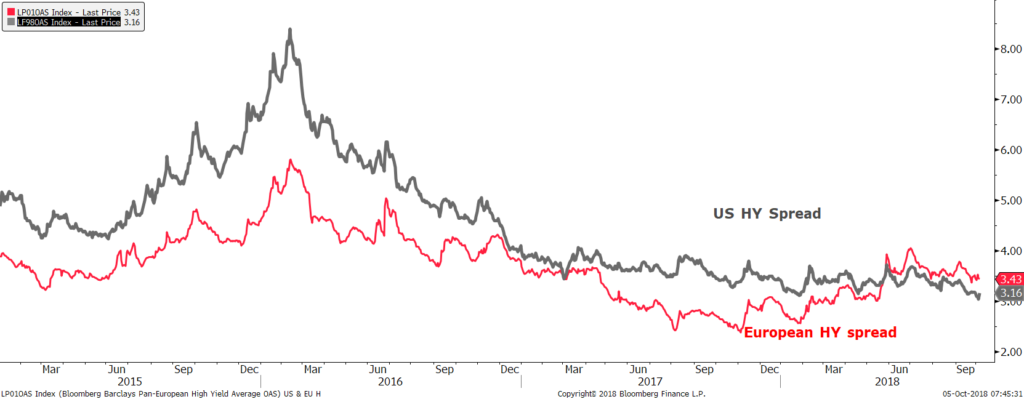
Date: 11 October, 2018 - Blog
Some signs of anxiety in the High Yield bond market are occurring. They remain very benign compared to the news flow. Firstly, the US 10-year yields surged up to 3.25% following a 10-days period of yields hovering below 3.10%. This seems to have caught markets off guard. Better than expected ADP employment report, a 21-year high ISM non-manufacturing indicator coupled with decidedly positive comments from Fed officials, notably Chairman Powell, formed a frothy cocktail to trigger the break higher in US yields and another leg of USD strengthening. Secondly, in the Euro area, the Italian drama has continued. After many days of market stress, the Italian government could finally scale down its 2020-21 deficit targets. Prime Minister Conte confirmed that the government will set the budget deficits at 2.4%, 2.1% and 1.8% for 2019, 2020 and 2021 respectively, lowering partially the targets on the back of EU pressures. Markets still await the publication of the Financial and Economic document, outlining the details.
In September, the biggest US HY ETF experienced one of its largest monthly outflows in history. However, US HY spreads reached their tightest level since 2007. This is mainly due to 2 factors: 1) very solid corporate earnings in the wake of the fiscal reform and 2) thanks to higher oil prices which have helped related companies to recover. So, the resilience of high-yield credit in a Fed raising rates environment led to an over extended strengthening.

This is not the same story in Europe. European HY spreads have already started to widen by more than 100 bps from historical low levels reached in Q4 last year. Amongst the reasons which have driven such a move, we can quote the ECB QE withdrawal announcement, the Italian stress and European political risks.
Even if some commentators are mentioning that having a wider spread in Europe than in the US represents an historical anomaly, we do not think this way. The European HY has only traded tighter than its US counterpart because of the European QE. At the difference of the Fed, the ECB has purchased a large amount of credit bonds, pushing investors downward in the credit spectrum. The normalization process should continue.
Higher government yields will prompt investors to dump riskier debt. However, government bond yields have climbed higher recently with little reaction from junk bonds while other segments of the credit universe have widened. This is a clear contrast to what happen earlier this year, when Treasury and high-yield credit yields rose in tandem.
- US high yield spread tightening mode is unsustainable
- A healthy repricing, like the European one, would be very welcome
- Emerging bonds, both sovereign and corporate, look more compelling





